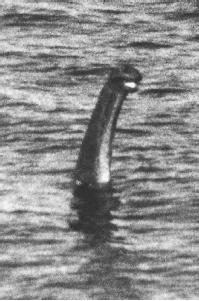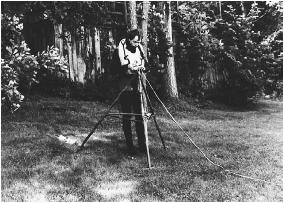Monsters of Land, Sea, and Air
Loch ness and other lake monsters
In 1936, Glasgow filmmaker Malcolm Irvine filmed a dark blob, approximately 30 feet in length, moving slowly across Loch Ness and offered what he believed to be proof that the most famous monster in the world actually existed in the Scottish lake where it had been sighted since the fifteenth century. With that brief filmstrip, Nessie mania had been brought into the twentieth century and has never subsided, seemingly growing stronger each year. And in spite of Irvine's intentions, his cinematic record of the Loch Ness Monster did not put an end to the controversy over the creature's existence.
Sightings of Nessie, most often described as a long-necked monster resembling a prehistoric brontosaurus, have been seen in and near Loch Ness since St. Columba made the first recorded sighting in 565, and nearly two million tourists each year come to Scotland to see if they might obtain a glimpse and a photograph of the elusive water beast. For the past several decades, volunteer Nessie spotters work in relays from mid-May to mid-October. Each volunteer is equipped with log pads, field glasses, and video cameras with telephoto lenses.
Could a prehistoric creature actually be living in a lake in Scotland? Loch Ness is certainly

One of the more verifiable of the sightings of a large creature in Loch Ness was made in the mid-1960s by Tim Dinsdale, a member of the Defense Ministry's Joint Air Reconnaissance Center (JARIC), who said that the 12- to-16-foot-long thing that he photographed traveling at a speed of 10 knots was "almost certainly animate."
On January 24, 1966, the Royal Air Force issued its analysis of the Dinsdale filmstrip, stating that the movement in the water of the "hump" of the creature indicated that the object was moving at a speed of about 10 miles per hour. After much technical discussion about the relative size and perspective of the "solid black, approximately triangular shape" (the hump) and a comparison of the unidentified creature with a motorboat moving in the same area (filmed immediately after the creature had swum past), the RAF conceded that the object was "not a surface vessel." And: "One can presumably rule out the idea that it is any sort of submarine vessel for various reasons, which leaves the conclusion that it probably is an animate object."
In the spring of 1968, David James, a former member of the British Parliament and head of the Loch Ness Phenomena Investigation Bureau, stated that in the studied opinion of the bureau, it should be made clear that there was no single monster that had lived in Loch Ness for a few thousand years. What the bureau was investigating was the possibility of an unidentified creature, "breeding, evolving like any other species…cut off from the sea, for 5,000 to 7,000 years." The Loch Ness Phenomena Investigation Bureau also wished to make one assertion clear: "There is something there. Too many reliable persons have seen too much, with too little possibility for coincidence, connivance, or conjuration to pass the entire matter off as only a figment of someone's imagination."
In 1968, Dr. Roy P. Mackal, University of Chicago biologist and head of the U.S. branch of the bureau, received a three-year grant from Field Enterprises Educational Corporation of Chicago that incorporated the services and the submarine of Dan Taylor. Although the expedition had sophisticated photographic equipment, biopsy darts, and other advanced research materials the murky brown waters of Loch Ness rendered all the underwater devices relatively useless. Mackal has theorized that the type of creature that most neatly fits the mass of descriptive evidence and photos compiled by researchers and witnesses has to be some kind of large aquatic mammal that would be capable of thriving above 50-degrees north latitude.
Dan Taylor of Hardeeville, South Carolina, accompanied Mackal on the 1969 quest for Nessie that was sponsored by Field Enterprises, publishers of the World Book Encyclopedia. He had been selected to become a part of the expedition because of his expertise with submarines, and he brought with him a small fiberglass submarine

D. Gordon Tucker, head of the electronic engineering department at Birmingham University, and a team of sonar experts did have better luck finding evidence of Nessie in the peat-stained loch waters with the special equipment that he had developed. During a number of expeditions to the lake (1968–70) and probing Loch Ness with sonar, Tucker's study appeared to provide evidence that a family of monsters does indeed inhabit the loch. In one 13-minute period, Tucker stated, sonar echoes defined large objects moving underwater. A massive object was recorded swimming at a speed as high as 17 miles per hour and diving at a rate of 450 feet a minute. "From the evidence we have," he concluded, "there is some animal life in the loch whose behavior is difficult to reconcile with that of fish."
In 1971, Bob Rines, a world-renowned patent attorney, physicist, and engineer, saw Nessie for himself. In the middle of the lake, his binoculars focused clearly on the creature for 10 minutes, he saw what looked like the back of an elephant. He shrugs off the skeptics who say that he merely saw a school of fish or a trick of the light. He is familiar with the dwellers of the deep. It was his groundbreaking research on sonar that was used to locate the Titanic.
In 1972, Rines set up an underwater sound stage at the lake, designed to trigger lights and start a camera whenever a large object passed the station. In 1975, the camera, rigged to roll at one frame every 45 seconds, captured the image of a creature that he believes resembles a plesiosaur, an aquatic, air-breathing dinosaur that should have been extinct 65 million years ago.
In March 1998, Scottish pet food salesman Richard White won a prize award of $825.00 for the best photograph of the Loch Ness Monster of the year. White had been on his way to the village of Foyers above the loch when he noticed an unusual disturbance in the water halfway across the loch toward Urquhart Castle on the opposite bank. He stopped to take a took, grabbed his camera, and began snapping photos of the monster in the water.
Gary Campbell, president of the Official Loch Ness Monster Fan Club, declared White's photos of "Nessie" to be among the best that he had ever seen. The fact that scientists using computer enhancement techniques had been unable to assess exactly what the pictures showed, Campbell said, only added to the mystery of Loch Ness. Although Nessie is far and away the most famous of all monsters inhabiting inland bodies of water, there are reports of equally large, equally strange aquatic creatures in lakes all over the world.

Comment about this article, ask questions, or add new information about this topic: